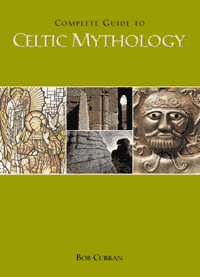 |


|
|||
 The Transmigration of Souls Besides both natural and geographical explanations for the Otherworld, there was a religious one. The Otherworld was also the abode of the dead. Archaeological evidence has drawn attention to the richness of Iron Age tombs and the preponderance of grave goods within them. This leads us to assume that the Celts probably believed in an Afterlife and, moreover, an Afterlife which was not all that different from the world that they knew. We have literary evidence from Caesar (Gallic Wars: VI) that seems to confirm this. In his description of the druids, he alluded to some of their lore that related directly to the movement of souls between one world and another or between one individual and another. He states: ‘…the druids attach particular importance to the belief that the soul (or spirit) does not perish but passes after death from one body to another’There is a strong suggestion that the spirit passed into a body inhabiting another world. Similarly Lucan (Pharsalia: I) stated that the Celts considered death as merely an interruption in a continuous life, as the spirit passed from one form into another, or from one world to another. Other writers, such as Diodorus Siculus drew attention to similar beliefs – that the soul was immortal and, as its body deteriorated with age, it simply moved to another, usually located in another world. Celtic beliefs of the Otherworld as Afterlife even found their way into the Roman poet Virgil’s Aeneid. The pagan creed certainly had an influence on Christian thinking and the soulnotion probably came from pagan tradition. Life in the Otherworld was not radically different from life in this world, and it was essential that those who crossed over were well equipped for the journey and for their arrival. High-ranking individuals were buried with all the trappings of their social status so that they could continue at the same social level in the Otherworld. Necessities of life were also included: enclosed in some tombs were chariots and/or carts, large amounts of food and changes of clothing. These, however, were the tombs of Celtic nobility and we have little evidence of how ordinary people approached the ‘crossing over’. Before the first century bc in parts of England, formal burial was accorded to only about six per cent of the population and we have little evidence to show how the rest were treated. The belief in rebirth was strong in the Celtic world (see The Great Wheel of Existence) and naturally tied in with the notion of another world. The belief also provided a comforting impression of continuity. The dead were not altogether gone, death was simply the same as passing from one room into another. From the Otherworld, those who had gone before watched and protected their descendants and took an interest in the communities that they had left. The next step in such a concept was to allow the dead to return if they wished. At special times of the year and in certain places in the countryside, said Celtic lore, the Veil between the two worlds was extremely thin and beings from both spheres could cross freely between them. Thus, the spirits, or reanimated corpses, of the dead were free to come back to visit briefly those whom they had left behind. The notion of the returning dead seems to have held no terrors for the ancient Celts, certainly not to the same extent that the idea of ghosts holds for the modern mind. In some parts of the Celtic world, great feasts and banquets were held to celebrate the return of the dead to the world of the living. The most famous of these was the Irish Féile na Marbh – the Feast of the Dead – which was held on 31 October, Hallowe'en, when the veil between the worlds was especially thin. At this time, the dead, usually in the form of animated corpses, would return to drink a glass of whiskey and eat a piece of bread with their descendants. Not to welcome a spirit into a house was to invite bad luck on the entire family, so the tradition said. In many cases, families simply left a glass of spirits and a piece of cake by the hearthstone on Hallowe'en night, leaving the fire in as well, before they went to bed. It was common in some rural areas of Ireland, to scatter fine ash around the hearth so that if it was disturbed in the morning, the household would know that it had received visitors from beyond the grave during the night. Company, especially that of their own descendants, seems to have been important to the returning dead. Souls who resided in the dreary, misty version of the Otherworld were desperate for warmth, friendship, and the company of living mortals. The traffic between the worlds worked both ways. There was a fear that those from the Otherworld could either take or coerce mortals to go with them when they returned. For example, mothers who had died in childbirth might be tempted to return in order to abduct the baby that they had left behind. Both Irish and Scottish folklore is littered with such attempts, some successful, others not. It was thought, particularly in Brittany, that dead men might return to take brides from the living world. There are numerous stories of shy or disfigured young girls, unable to find a partner, who unwittingly marry malignant corpses and are taken back ‘to the cold and lonely grave’. The motif is used to great effect in a number of Breton tales and forms the basis for the Irish writer, Sheridan Le Fanu's famous story, Schalken the Painter. In this tale, set in the Holland of two centuries ago, Rose Velderkaust, the niece of the painter Gerard Douw and only love of his apprentice, Godfrey Schalken, is finally married to an aged suitor, Wilken Vanderhousen of Rotterdam, who it transpires is one of the unquiet dead. Although Schalken tries to prevent the match, he is unsuccessful and the awful corpse carries Rose away. But Schalken is granted one last glimpse into the Otherworld. Many years later in Rotterdam, before a funeral he gets chatting to the old sexton who tells him where the body is to be entombed. Le Fanu was drawing not on any Dutch tradition but on his own Irish folklore concerning the living dead and the Otherworld. The glimpse into the antique Dutch apartment is strongly reminiscent of many Irish tales of glimpses into the other reality. In the tale, Schalken was able to return from the Otherworld of the dead in a single night. Others were not so lucky. Some returned from the realm beyond after a period of seven years; some did not return at all. It was believed that the realm of the dead was terribly close to this world and that the dead were continually watching for mortals whom they could lure or pull across into their own sphere. With the malignant dead so near at hand, mortals had to be continually wary. Besides being the realm of the dead, the Otherworld had other aspects in certain parts of the Celtic realm. This Chapter extract continues with The Celtic Otherworld - Part 3>>>.
From Complete Guide to Celtic Mythology by Bob Curran |
[ Back to top ]
All Material © 1999-2006 Irelandseye.com and contributors

